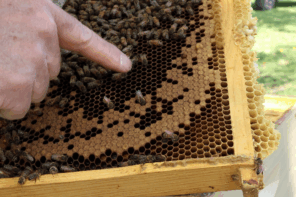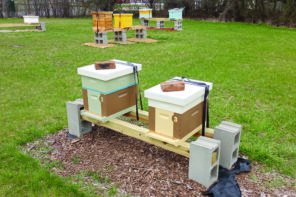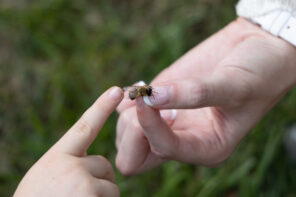Earl Hoffman
- Please let me share some critical thoughts on supers, hive frames and comb
- As I shared before, there are windows of opportunity to achieve desired results
- Let me suggest some ideas to consider during your next comb encounter
- Drawn comb is your golden treasure, that allows the beekeeper to manage the hives
- Without drawn comb, you have nothing, nowhere to store nectar, pollen or lay eggs
- A plastic or wood frame and a foundation material is worthless to the honey bees
- Please let me discuss some ideas on bait comb, comb creation and types of foundation
- If you place an empty super with new frames on top of a healthy hive, it will not draw comb
- The wax workers can be active because of a honey flow or heavy sugar feeding
- If the temperature is too cold, no new wax. If the temperature is too hot, no new wax
- If you give bees new wax foundation during a dearth, they remove the wax many times
- Using a Spring swarm can be an easy way to get foundation drawn into fresh comb frames
- Bees move wax as they see fit, why create more when they can just move it?
- Many supers hold either 10 or eight frames; always start with a full super of frames
- You can remove one of the frames later once it is drawn, to help hive inspections
- Running nine frames in a 10-frame box or seven frames in an eight-frame box reduces queen damage
- I suggest placing drawn comb in the middle of the foundation frames to bait the bees
- One or two frames of older drawn comb will encourage the bees to work up into the super
- Consider swapping new foundation down and older drawn comb up, a few frames at a time
- Yes, I know that the bees sometimes create ladder comb between the frames, but that’s OK.
- Wax foundation with wire supports, is challenging and time consuming to install
- Plastic frame foundation comes in lots of colors and sizes: some good, some not so good
- Plastic comes in black, white, yellow, green and other colors.
- Black color makes looking at eggs and larva easier, yellow helps with honey grading
- Green color is used on frames that are drone cell size; they are either deep or medium
- Over the years, I have had some plastic foundation that the bees refuse to work.
- No matter how much fresh, pure bees wax I placed on the plastic foundation, it was a no go
- I also have white plastic frames that the bees go to like a magnet; the cells are perfect
- The only real solution to working with plastic foundation, is coat it with lots of beeswax
- The issue with full plastic frames is the ears break and some frames do not fit extractors
- The other thought I suggest is combs need to be rotated out of the hive every two to four years
- Old combs are a reservoir of chemicals because chemicals are attracted to lipids (fatty acids)
- I suggest that a cadence be created so that some new comb creation happens every year
- Also, the other thought that you may have already had, is to mark the year on the top bar
- In summary, I repeat, timing is everything in beekeeping; too late and it’s not happening
- I suggest that each Spring, during hive management, you consider creating new drawn comb
- Either feed, feed, feed sugar water or time your new wax creation during a nectar flow
- Brood comb frames need to be created, not just the honey combs
- Weak hives will not draw comb, best to give the foundation to a super strong hive
- Look for the spots of white new wax on the top bars during a nectar flow; that is your signal
- During your bee journey, please consider making new honey bee comb your next priority!








